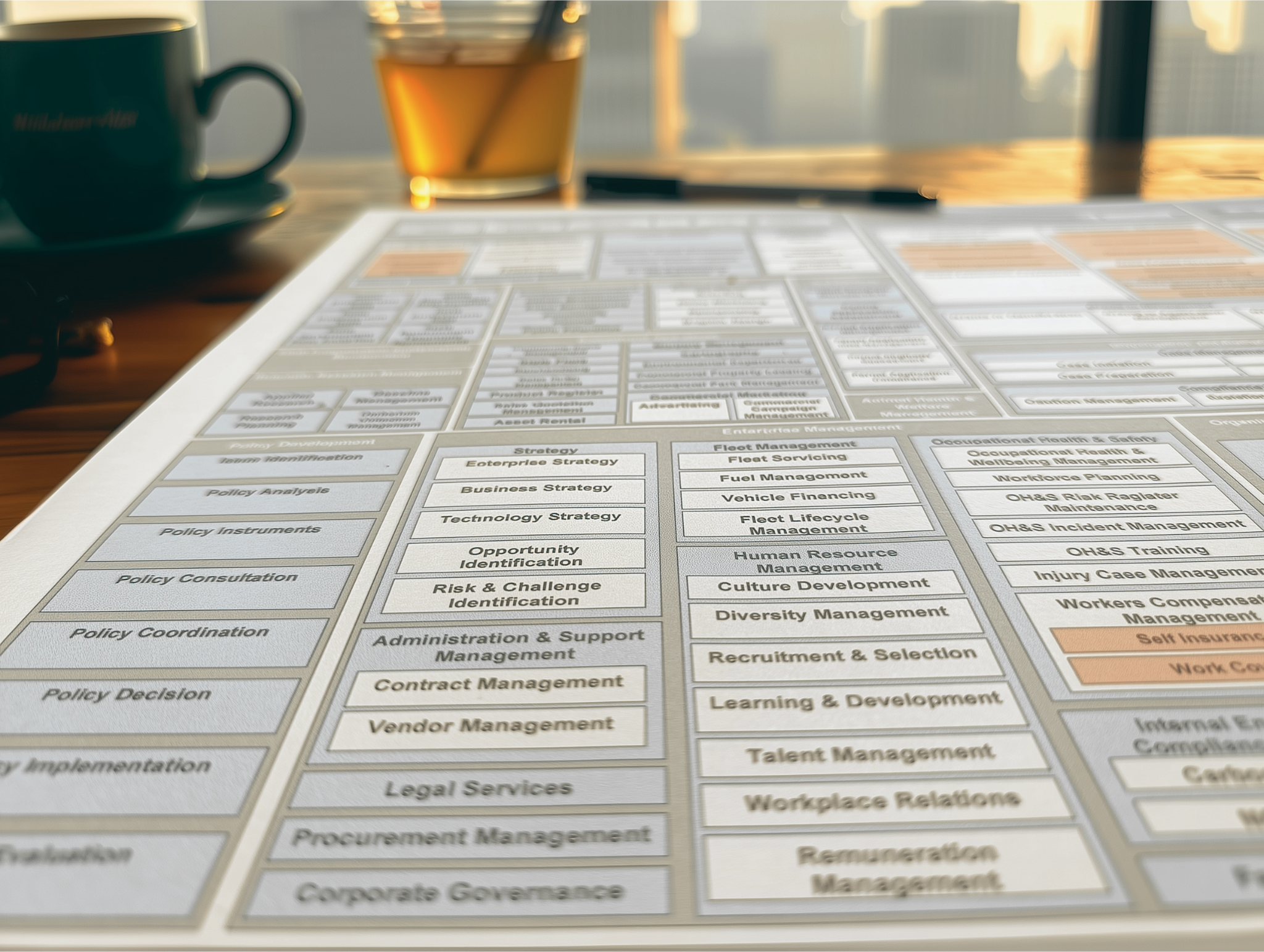Present the Draft Model for Feedback
After identifying and organising the organisation capabilities, the next critical step is to validate the model with the key stakeholders. Validation ensures that the model accurately reflects the organisation’s operations and objectives. It also helps secure buy-in from leadership and other departments, confirming that the model is useful for both strategic planning and day-to day operations.
What to Do
- Share the initial model: Present the high-level and sub-capabilities in a clear, easy-to-follow format. Visual tools such as diagrams, charts, or hierarchies work best for ensuring that stakeholders can easily understand the structure.
- Solicit feedback from all stakeholders: Ensure that you gather input from a diverse group of stakeholders, including senior leadership, department heads, and subject matter experts. They should confirm that the capabilities and sub-capabilities accurately represent their areas.
- Host feedback sessions: Organise workshops or one-on-one meetings where stakeholders can review the model in detail and provide constructive feedback.

Things to Consider
- Language clarity: Ensure that the terminology used in the model is clear and understood by all departments. This model will serve as a common language across the organisation, so it’s crucial to avoid jargon or overly technical terms unless the model is specifically for a technical audience.
- Reinforce the stable nature of capabilities: Remind stakeholders that the model focuses on stable organisation capabilities, not tasks or processes that may change over time. This will help keep discussions focused on long-term organisation needs.
Potential Issues
- Language clarity: Ensure that the terminology used in the model is clear and understood by all departments. This model will serve as a common language across the organisation, so it’s crucial to avoid jargon or overly technical terms unless the model is specifically for a technical audience.
- Reinforce the stable nature of capabilities: Remind stakeholders that the model focuses on stable organisation capabilities, not tasks or processes that may change over time. This will help keep discussions focused on long-term organisation needs.
Refine the Model

What to Do
- Incorporate feedback: Based on the sessions with stakeholders, adjust the model where necessary. Ensure that feedback is balanced and aligns with the overall purpose of the model.
- Revisit key decisions: If certain capabilities were debated or unclear, revisit those sections with relevant stakeholders to reach a final agreement. Make sure the final model reflects the collective input of the entire organisation.
- Create multiple views if necessary: If feedback indicates that different audiences (technical vs non-technical) require different levels of detail, consider creating multiple views of the model. For example, a high-level version for senior leadership and a more detailed version for technical teams.
Things to Consider
- Version control: Ensure that changes to the model are documented and tracked. Keep a record of previous versions in case there’s a need to revert or cross-check decisions made earlier in the process.
- Balance stakeholder input: While it’s important to incorporate feedback, be careful not to over-customise the model for specific departments. The organisation capability model should serve the entire organisation, not just one area.
Potential Issues
- Overcomplicating the model: In an effort to incorporate feedback, there’s a risk of adding too many details or sub-capabilities. Keep the model focused on high-level capabilities that represent what the organisation needs to function, rather than detailed tasks or workflows.
- Incomplete validation: If feedback is not gathered from all key stakeholders, critical capabilities might be missed. Make sure that the validation process is thorough and that all relevant departments have had the opportunity to contribute.
Final Approval
What to Do
- Get sign-off from leadership: Once the model has been refined, present it to senior leadership for final approval. Their sign-off is crucial for the model to be adopted across the organisation.
- Communicate the final model: Once approved, communicate the final model to all relevant departments. Ensure they understand how it will be used and how it can inform decision-making at various levels.

Things to Consider
- Implementation readiness: Ensure that the organisation capability model is not just seen as a theoretical exercise but something that can be applied to real-world strategic initiatives or operational improvements.
- Plan for ongoing updates: While the model should remain stable over time, there should be a plan for periodic reviews to ensure it stays relevant as the organisation evolves.
Potential Issues
- Delayed approval: Leadership sign-off can sometimes be delayed due to competing priorities. Keep senior leaders informed of progress throughout the process to avoid surprises at the final review stage.
Next Step: Maintain the Business Capability Model
Now that the model is validated, it’s time to effectively communicate it across the organisation and ensure it remains relevant through governance and maintenance procedures.

